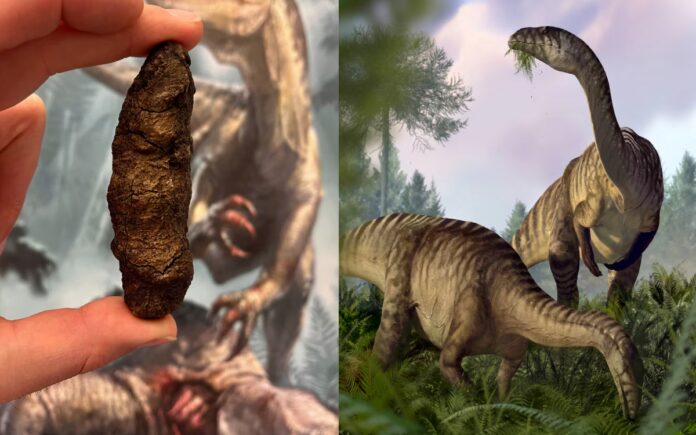London: The extinction event caused by an asteroid 66 million years ago is well-known for ending the reign of dinosaurs. However, the journey of how these creatures rose to dominance remains a mystery. New research, relying on fossilized feces and vomit, provides fresh insights into how dinosaurs outpaced their competition during the Triassic Period. The study focused on fossil-rich regions in Poland, shedding light on this pivotal moment in Earth’s history.
Dinosaurs first appeared about 230 million years ago, initially overshadowed by other large animals such as semi-aquatic crocodile relatives and elephant-sized plant-eaters related to mammals. By 200 million years ago, dinosaurs emerged as the dominant species, with their primary competitors extinct.
“We approached the rise of dinosaurs in a completely novel way. We analyzed feeding evidence to deduce the ecological role of dinosaurs across their first 30 million years of evolution,” said Martin Qvarnström, a paleontologist from Uppsala University in Sweden and lead author of the study, published in Nature.
At first, dinosaurs were opportunists, feeding on a variety of food sources like insects, fish, and other small creatures. Over time, larger, more specialized dinosaur predators evolved, and herbivorous dinosaurs became better equipped to take advantage of newly emerged plants in a humidifying climate.
Fossilized feces, known as coprolites, and vomit, called regurgitates, together referred to as bromalites, are key to understanding feeding patterns. By examining undigested remnants in these fossils, scientists can reconstruct food webs and better understand past ecosystems.
“We studied over 100 kilograms (220 pounds) of fossilized feces,” said Grzegorz Niedźwiedzki, a paleontologist and geologist at Uppsala University and the Polish Geological Institute.
Determining the origin of coprolites requires careful analysis. Researchers identify the source by considering factors such as the size and shape of the fossilized feces, the type of undigested food it contains, and the digestive traits of related modern animals.
For example, the 20-foot-long (6-meter) Polonosuchus, a reptilian predator related to crocodiles, left large coprolites containing thoroughly digested mass. “We found large, sausage-shaped coprolites with highly digested remains where we also found bones of Polonosuchus,” Niedźwiedzki explained.
In contrast, sites where dinosaur bones and tracks were found yielded coprolites with undigested bones, fish remains, and teeth, indicating a faster digestion process compared to modern crocodiles.
Silesaurus, an early dinosaur relative, was an opportunist feeding on insects, fish, and plants. “The first dinosaur relative in the area, Silesaurus, was a little thing that ate bugs, fish, and plants,” Qvarnström noted, highlighting the well-preserved insect remains found in coprolites.
Also Read | Cuban Sugar Industry Decline Reflects Broader Food Crisis
Towards the end of the Triassic, large herbivorous and carnivorous dinosaurs began to appear. As Earth’s volcanic activity intensified, new plant varieties flourished, benefiting herbivorous dinosaurs. This increase in plant-eaters likely spurred the evolution of larger carnivores. By 200 million years ago, meat-eating dinosaurs, reaching lengths of up to 26 feet (8 meters), and plant-eaters up to 33 feet (10 meters), dominated the land.
One remarkable find was the coprolites of Smok, a 20-foot-long (6-meter) carnivorous dinosaur relative. The fossils revealed a bone-crushing diet, reminiscent of later dinosaurs like Tyrannosaurus. “The coprolites showed Smok’s preference for bone-crushing, obtaining nutritious marrow—a trait seen in later dinosaurs like Tyrannosaurus,” Niedźwiedzki explained.
Also Read | FDA Rejects Applied Therapeutics’ Galactosemia Drug, Govorestat, Shares Plunge 84%
Herbivorous dinosaur coprolites also provided intriguing discoveries. “An interesting finding was the presence of geochemical signals from burnt plant remains and charcoal,” said Niedźwiedzki. “Did the dinosaurs consume charcoal from burned plants? Ferns in the coprolites may have been toxic, and the charcoal might have neutralized these toxins.”
This study of fossilized feces and vomit gives us a unique window into the evolution of dinosaurs, shedding new light on how they rose to supremacy over their competitors during the Triassic Period.



